2017 FORD F SERIES MOTORHOME AND COMMERCIAL CHASSIS air condition
[x] Cancel search: air conditionPage 53 of 164
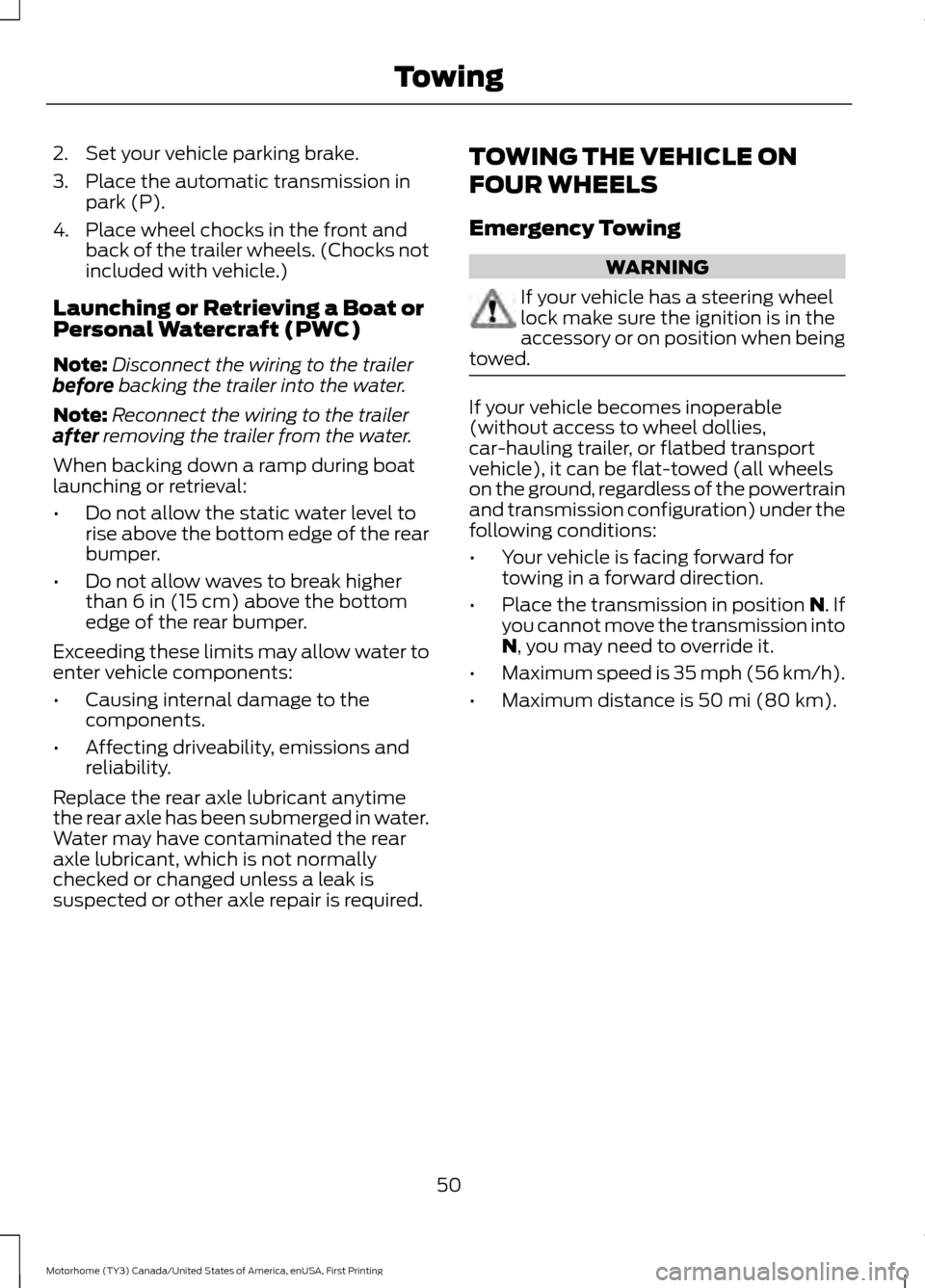
2. Set your vehicle parking brake.
3. Place the automatic transmission in
park (P).
4. Place wheel chocks in the front and back of the trailer wheels. (Chocks not
included with vehicle.)
Launching or Retrieving a Boat or
Personal Watercraft (PWC)
Note: Disconnect the wiring to the trailer
before backing the trailer into the water.
Note: Reconnect the wiring to the trailer
after
removing the trailer from the water.
When backing down a ramp during boat
launching or retrieval:
• Do not allow the static water level to
rise above the bottom edge of the rear
bumper.
• Do not allow waves to break higher
than
6 in (15 cm) above the bottom
edge of the rear bumper.
Exceeding these limits may allow water to
enter vehicle components:
• Causing internal damage to the
components.
• Affecting driveability, emissions and
reliability.
Replace the rear axle lubricant anytime
the rear axle has been submerged in water.
Water may have contaminated the rear
axle lubricant, which is not normally
checked or changed unless a leak is
suspected or other axle repair is required. TOWING THE VEHICLE ON
FOUR WHEELS
Emergency Towing WARNING
If your vehicle has a steering wheel
lock make sure the ignition is in the
accessory or on position when being
towed. If your vehicle becomes inoperable
(without access to wheel dollies,
car-hauling trailer, or flatbed transport
vehicle), it can be flat-towed (all wheels
on the ground, regardless of the powertrain
and transmission configuration) under the
following conditions:
•
Your vehicle is facing forward for
towing in a forward direction.
• Place the transmission in position N. If
you cannot move the transmission into
N
, you may need to override it.
• Maximum speed is 35 mph (56 km/h).
• Maximum distance is
50 mi (80 km).
50
Motorhome (TY3) Canada/United States of America, enUSA, First Printing Towing
Page 54 of 164
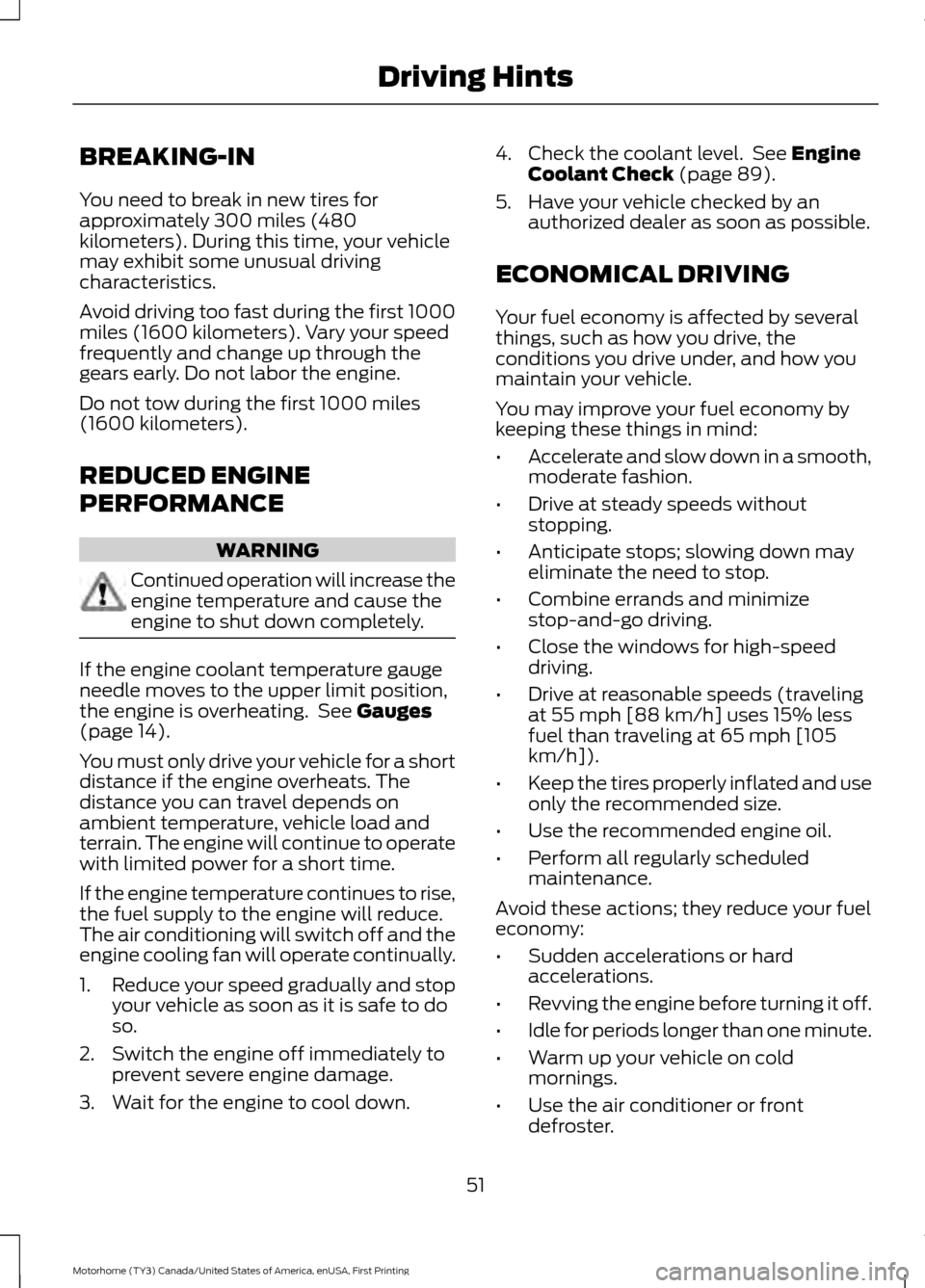
BREAKING-IN
You need to break in new tires for
approximately 300 miles (480
kilometers). During this time, your vehicle
may exhibit some unusual driving
characteristics.
Avoid driving too fast during the first 1000
miles (1600 kilometers). Vary your speed
frequently and change up through the
gears early. Do not labor the engine.
Do not tow during the first 1000 miles
(1600 kilometers).
REDUCED ENGINE
PERFORMANCE
WARNING
Continued operation will increase the
engine temperature and cause the
engine to shut down completely.
If the engine coolant temperature gauge
needle moves to the upper limit position,
the engine is overheating. See Gauges
(page 14).
You must only drive your vehicle for a short
distance if the engine overheats. The
distance you can travel depends on
ambient temperature, vehicle load and
terrain. The engine will continue to operate
with limited power for a short time.
If the engine temperature continues to rise,
the fuel supply to the engine will reduce.
The air conditioning will switch off and the
engine cooling fan will operate continually.
1. Reduce your speed gradually and stop
your vehicle as soon as it is safe to do
so.
2. Switch the engine off immediately to prevent severe engine damage.
3. Wait for the engine to cool down. 4. Check the coolant level. See
Engine
Coolant Check (page 89).
5. Have your vehicle checked by an authorized dealer as soon as possible.
ECONOMICAL DRIVING
Your fuel economy is affected by several
things, such as how you drive, the
conditions you drive under, and how you
maintain your vehicle.
You may improve your fuel economy by
keeping these things in mind:
• Accelerate and slow down in a smooth,
moderate fashion.
• Drive at steady speeds without
stopping.
• Anticipate stops; slowing down may
eliminate the need to stop.
• Combine errands and minimize
stop-and-go driving.
• Close the windows for high-speed
driving.
• Drive at reasonable speeds (traveling
at 55 mph [88 km/h] uses 15% less
fuel than traveling at 65 mph [105
km/h]).
• Keep the tires properly inflated and use
only the recommended size.
• Use the recommended engine oil.
• Perform all regularly scheduled
maintenance.
Avoid these actions; they reduce your fuel
economy:
• Sudden accelerations or hard
accelerations.
• Revving the engine before turning it off.
• Idle for periods longer than one minute.
• Warm up your vehicle on cold
mornings.
• Use the air conditioner or front
defroster.
51
Motorhome (TY3) Canada/United States of America, enUSA, First Printing Driving Hints
Page 55 of 164
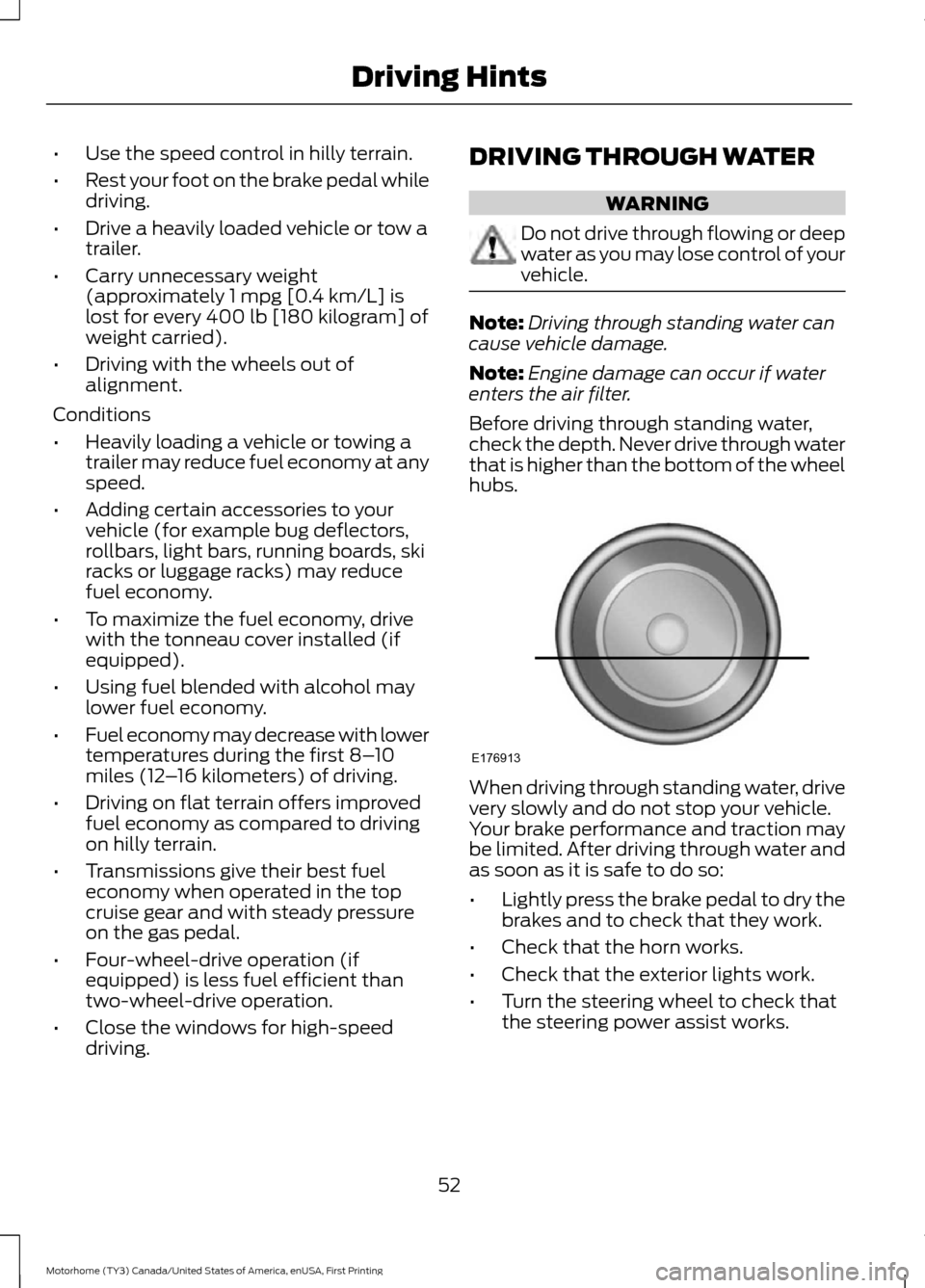
•
Use the speed control in hilly terrain.
• Rest your foot on the brake pedal while
driving.
• Drive a heavily loaded vehicle or tow a
trailer.
• Carry unnecessary weight
(approximately 1 mpg [0.4 km/L] is
lost for every 400 lb [180 kilogram] of
weight carried).
• Driving with the wheels out of
alignment.
Conditions
• Heavily loading a vehicle or towing a
trailer may reduce fuel economy at any
speed.
• Adding certain accessories to your
vehicle (for example bug deflectors,
rollbars, light bars, running boards, ski
racks or luggage racks) may reduce
fuel economy.
• To maximize the fuel economy, drive
with the tonneau cover installed (if
equipped).
• Using fuel blended with alcohol may
lower fuel economy.
• Fuel economy may decrease with lower
temperatures during the first 8– 10
miles (12 –16 kilometers) of driving.
• Driving on flat terrain offers improved
fuel economy as compared to driving
on hilly terrain.
• Transmissions give their best fuel
economy when operated in the top
cruise gear and with steady pressure
on the gas pedal.
• Four-wheel-drive operation (if
equipped) is less fuel efficient than
two-wheel-drive operation.
• Close the windows for high-speed
driving. DRIVING THROUGH WATER WARNING
Do not drive through flowing or deep
water as you may lose control of your
vehicle.
Note:
Driving through standing water can
cause vehicle damage.
Note: Engine damage can occur if water
enters the air filter.
Before driving through standing water,
check the depth. Never drive through water
that is higher than the bottom of the wheel
hubs. When driving through standing water, drive
very slowly and do not stop your vehicle.
Your brake performance and traction may
be limited. After driving through water and
as soon as it is safe to do so:
•
Lightly press the brake pedal to dry the
brakes and to check that they work.
• Check that the horn works.
• Check that the exterior lights work.
• Turn the steering wheel to check that
the steering power assist works.
52
Motorhome (TY3) Canada/United States of America, enUSA, First Printing Driving HintsE176913
Page 62 of 164
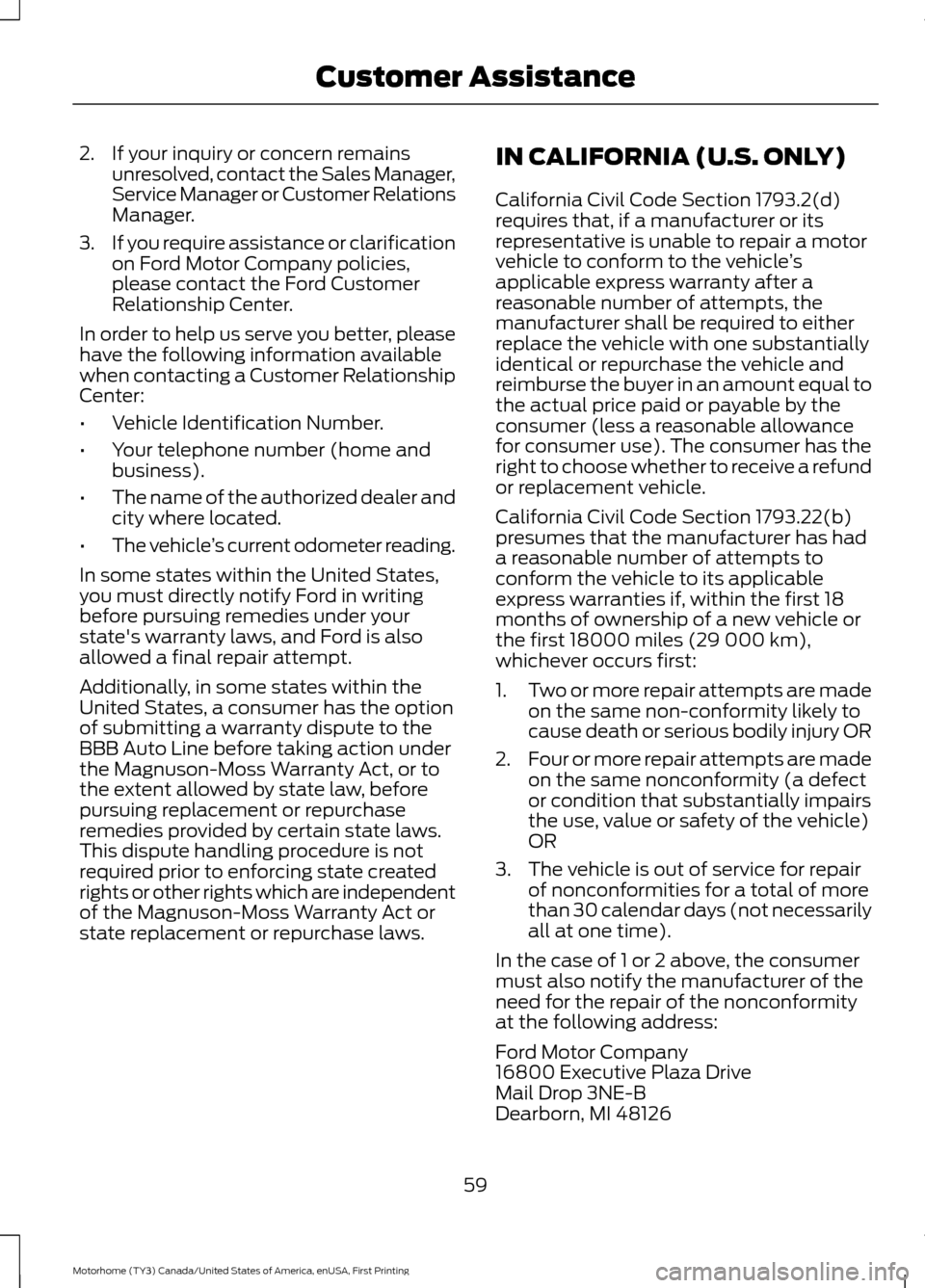
2. If your inquiry or concern remains
unresolved, contact the Sales Manager,
Service Manager or Customer Relations
Manager.
3. If you require assistance or clarification
on Ford Motor Company policies,
please contact the Ford Customer
Relationship Center.
In order to help us serve you better, please
have the following information available
when contacting a Customer Relationship
Center:
• Vehicle Identification Number.
• Your telephone number (home and
business).
• The name of the authorized dealer and
city where located.
• The vehicle ’s current odometer reading.
In some states within the United States,
you must directly notify Ford in writing
before pursuing remedies under your
state's warranty laws, and Ford is also
allowed a final repair attempt.
Additionally, in some states within the
United States, a consumer has the option
of submitting a warranty dispute to the
BBB Auto Line before taking action under
the Magnuson-Moss Warranty Act, or to
the extent allowed by state law, before
pursuing replacement or repurchase
remedies provided by certain state laws.
This dispute handling procedure is not
required prior to enforcing state created
rights or other rights which are independent
of the Magnuson-Moss Warranty Act or
state replacement or repurchase laws. IN CALIFORNIA (U.S. ONLY)
California Civil Code Section 1793.2(d)
requires that, if a manufacturer or its
representative is unable to repair a motor
vehicle to conform to the vehicle
’s
applicable express warranty after a
reasonable number of attempts, the
manufacturer shall be required to either
replace the vehicle with one substantially
identical or repurchase the vehicle and
reimburse the buyer in an amount equal to
the actual price paid or payable by the
consumer (less a reasonable allowance
for consumer use). The consumer has the
right to choose whether to receive a refund
or replacement vehicle.
California Civil Code Section 1793.22(b)
presumes that the manufacturer has had
a reasonable number of attempts to
conform the vehicle to its applicable
express warranties if, within the first 18
months of ownership of a new vehicle or
the first 18000 miles (29 000 km),
whichever occurs first:
1. Two or more repair attempts are made
on the same non-conformity likely to
cause death or serious bodily injury OR
2. Four or more repair attempts are made
on the same nonconformity (a defect
or condition that substantially impairs
the use, value or safety of the vehicle)
OR
3. The vehicle is out of service for repair of nonconformities for a total of more
than 30 calendar days (not necessarily
all at one time).
In the case of 1 or 2 above, the consumer
must also notify the manufacturer of the
need for the repair of the nonconformity
at the following address:
Ford Motor Company
16800 Executive Plaza Drive
Mail Drop 3NE-B
Dearborn, MI 48126
59
Motorhome (TY3) Canada/United States of America, enUSA, First Printing Customer Assistance
Page 68 of 164

FUSE SPECIFICATION CHART
F53 Power Distribution Box
WARNINGS
Always disconnect the battery before
servicing high current fuses.
To reduce risk of electrical shock,
always replace the cover to the
power distribution box before
reconnecting the battery or refilling fluid
reservoirs. Locate the power distribution box in the
engine compartment. It has high-current
fuses that protect your vehicle's main
electrical systems from overloads.
If the battery has been disconnected and
reconnected, you will need to reset some
features. See Changing the 12V Battery
(page 98).
Protected components
Fuse amp rating
Fuse or relay number
Power brake assist module – Hydromax.
5A*
1
Air conditioning compressor clutch.
10A*
2
Catalyst monitor sensor.
20A*
3
65
Motorhome (TY3) Canada/United States of America, enUSA, First Printing FusesE161519
Page 70 of 164
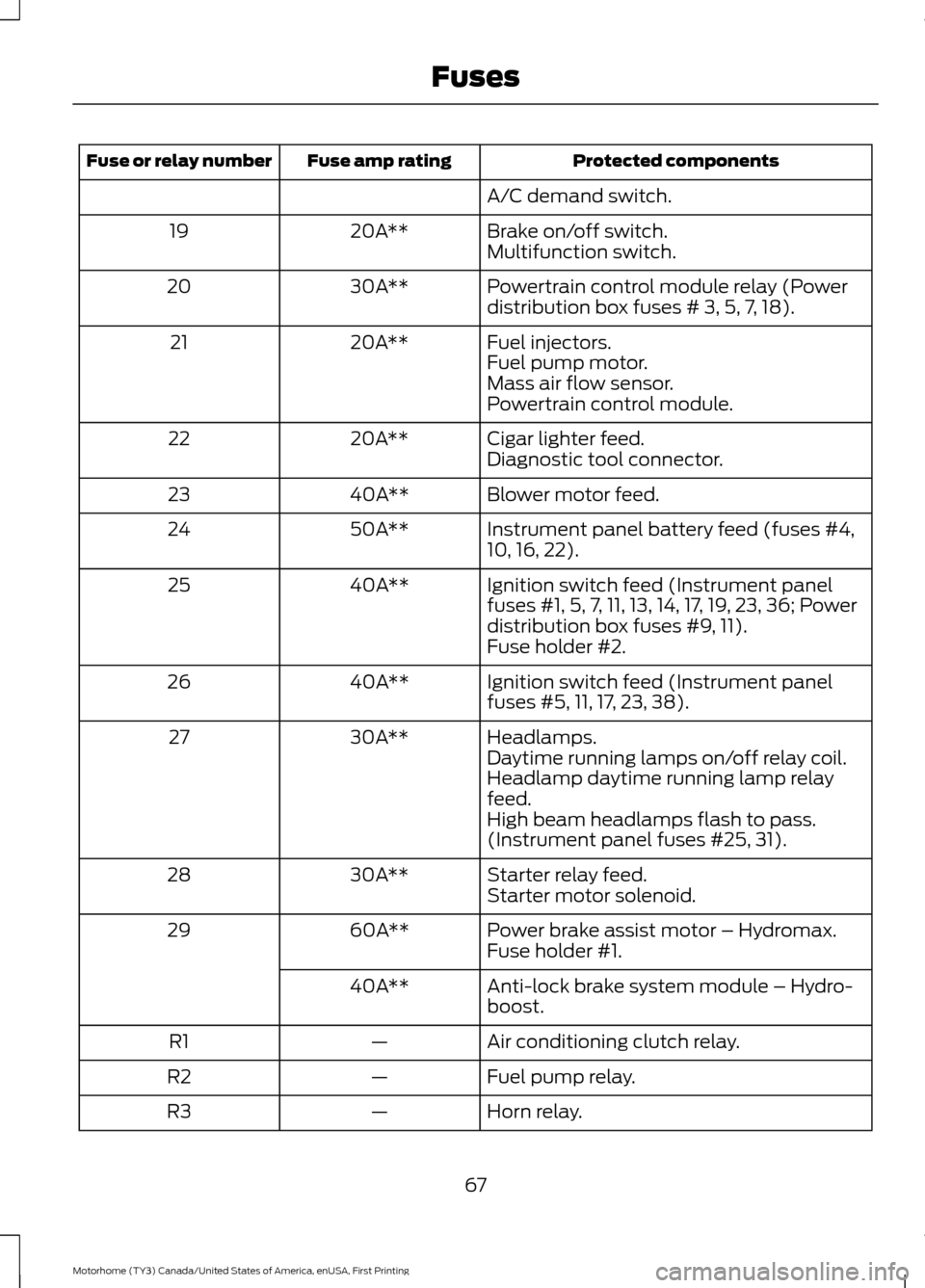
Protected components
Fuse amp rating
Fuse or relay number
A/C demand switch.
Brake on/off switch.
20A**
19
Multifunction switch.
Powertrain control module relay (Power
distribution box fuses # 3, 5, 7, 18).
30A**
20
Fuel injectors.
20A**
21
Fuel pump motor.
Mass air flow sensor.
Powertrain control module.
Cigar lighter feed.
20A**
22
Diagnostic tool connector.
Blower motor feed.
40A**
23
Instrument panel battery feed (fuses #4,
10, 16, 22).
50A**
24
Ignition switch feed (Instrument panel
fuses #1, 5, 7, 11, 13, 14, 17, 19, 23, 36; Power
distribution box fuses #9, 11).
40A**
25
Fuse holder #2.
Ignition switch feed (Instrument panel
fuses #5, 11, 17, 23, 38).
40A**
26
Headlamps.
30A**
27
Daytime running lamps on/off relay coil.
Headlamp daytime running lamp relay
feed.
High beam headlamps flash to pass.
(Instrument panel fuses #25, 31).
Starter relay feed.
30A**
28
Starter motor solenoid.
Power brake assist motor – Hydromax.
60A**
29
Fuse holder #1.
Anti-lock brake system module – Hydro-
boost.
40A**
Air conditioning clutch relay.
—
R1
Fuel pump relay.
—
R2
Horn relay.
—
R3
67
Motorhome (TY3) Canada/United States of America, enUSA, First Printing Fuses
Page 71 of 164

Protected components
Fuse amp rating
Fuse or relay number
Starter relay.
—
R4
Blower motor relay.
—
R5
Powertrain control module relay.
—
R6
Fuel pump diode.
—
Diode 1
Air conditioning clutch diode.
—
Diode 2
*Mini fuses.
**Maxi fuses.
F59 Power Distribution Box 68
Motorhome (TY3) Canada/United States of America, enUSA, First Printing FusesE197657
Page 72 of 164
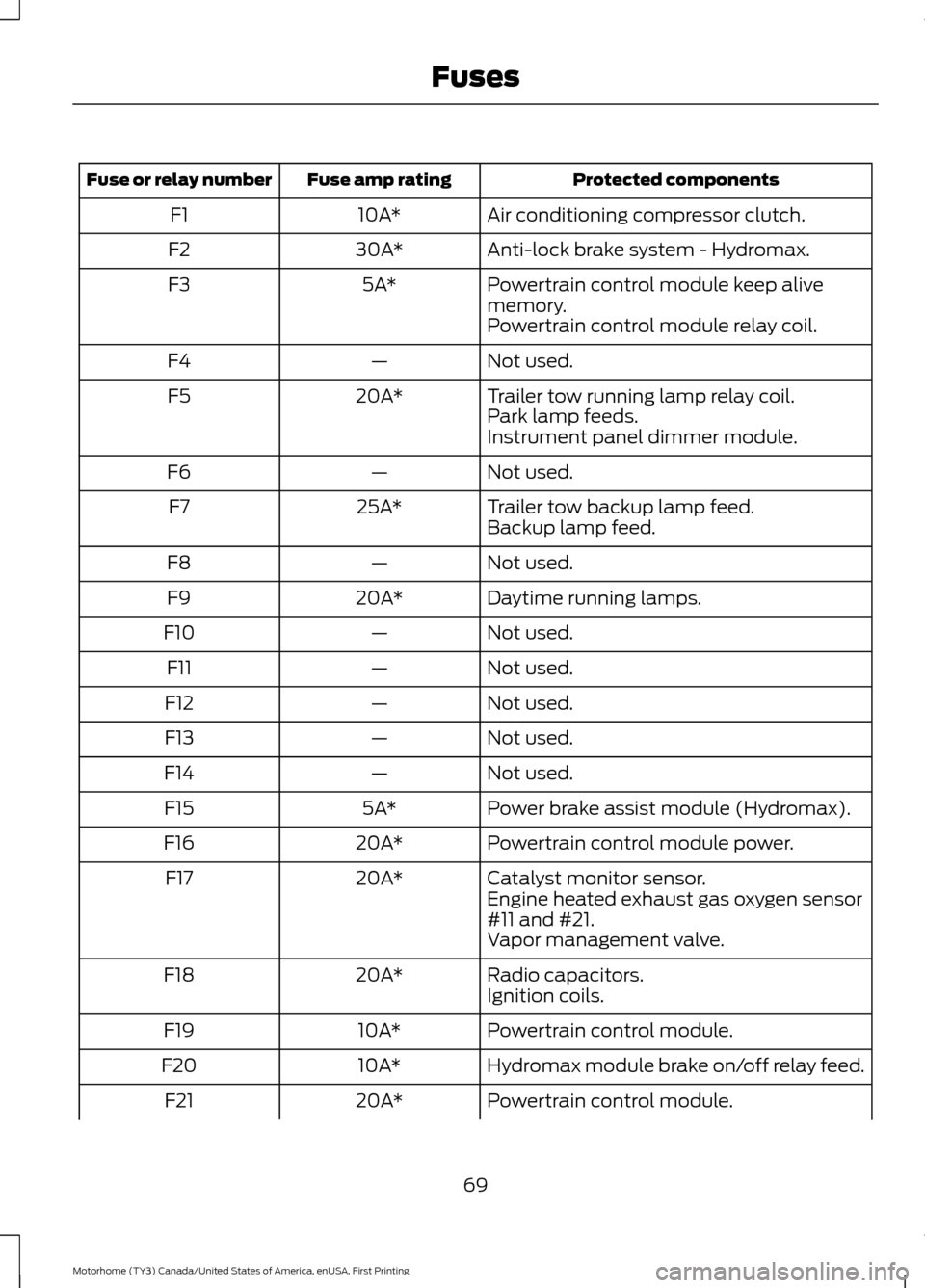
Protected components
Fuse amp rating
Fuse or relay number
Air conditioning compressor clutch.
10A*
F1
Anti-lock brake system - Hydromax.
30A*
F2
Powertrain control module keep alive
memory.
5A*
F3
Powertrain control module relay coil.
Not used.
—
F4
Trailer tow running lamp relay coil.
20A*
F5
Park lamp feeds.
Instrument panel dimmer module.
Not used.
—
F6
Trailer tow backup lamp feed.
25A*
F7
Backup lamp feed.
Not used.
—
F8
Daytime running lamps.
20A*
F9
Not used.
—
F10
Not used.
—
F11
Not used.
—
F12
Not used.
—
F13
Not used.
—
F14
Power brake assist module (Hydromax).
5A*
F15
Powertrain control module power.
20A*
F16
Catalyst monitor sensor.
20A*
F17
Engine heated exhaust gas oxygen sensor
#11 and #21.
Vapor management valve.
Radio capacitors.
20A*
F18
Ignition coils.
Powertrain control module.
10A*
F19
Hydromax module brake on/off relay feed.
10A*
F20
Powertrain control module.
20A*
F21
69
Motorhome (TY3) Canada/United States of America, enUSA, First Printing Fuses